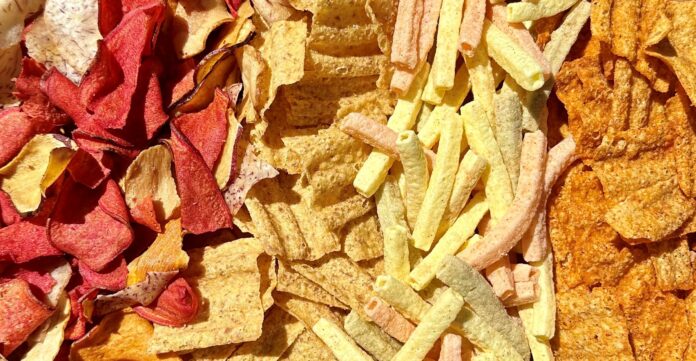
By Neval Ceyhun, Senior Scientist – Strategy of Nutrition North America, Unilever
Radiant energy under vacuum (REV) technology is a process in which microwave energy and vacuum pressure are combined to deliver high-speed and low-temperature food dehydration. REV is effective for drying fruits, vegetables, herbs, meat, and seafood under or above their freezing points. Perhaps its biggest potential today is in creating healthy snacks. At a time when consumer data indicates a greater public awareness of and interest in healthy snacks, REV can become a distinct marketplace advantage. One example of its success comes from chickpeas and zucchini veggie snacks, which have produced higher positive numbers for fiber, protein, and potassium sources for daily intake. REV dehydration of pineapples has generated similar results. These trends indicate that REV is at the forefront of creating an attractive, wider, and healthier market of snacks that retain their nutritional value.
The rise of healthy snacking
In the larger food landscape, snacking and snack foods are best thought of as buffers between larger, main meals like lunch or dinner, with snacking bridging the time between meals. Snacking is very common. According to NielsenIQ research from 2022, consumers reported that snacking or small meals made up 73% of eating occasions.
Beyond this general understanding, individuals will use snacking to provide different benefits depending on their needs. The Hartman Group’s Modern Snacking Framework, developed as part of the 2021 “Snacking: Emerging, Evolving and Disrupted” report, shows that snacking generally satisfies at least one of four main goals: nourishment, optimization, pleasure, and distraction. Of these four, however, nourishment and pleasure are most common: 54% of snacking seeks to provide nourishment and 51% provides pleasure.
Healthy snacking aims to fulfill many of the same roles, but with a focus on nutrition and well-being, moving away from more traditional snacks that may be highly processed or contain significant amounts of salt or sugar. Industry research suggests that when it comes to food, consumer interest in health is increasing, especially since the beginning of tthe COVID-19 pandemic. NielsenIQ’s research reports 42% of consumers said they have adopted healthier eating habits in the last two years, with an additional 42% reporting they are consuming less salt, saturated fat, and sugar.
In October 2022, McKinsey published a report that surveyed consumers in the United States, United Kingdom, France, and Germany, and found similar results. Healthy eating which the report identified as reduced consumption of salt, sugar, and processed foods, was a top priority for 50% of consumers surveyed. In the United States, 38% of respondents said they have changed their eating habits to prioritize eating more healthily since the COVID-19 pandemic.
While demand for healthier, more nourishing snacks has increased, it’s important to remember that pleasure is also strongly associated with snacking, and flavor is a key component of pleasure. To meet consumer demand for healthier foods in the long term, it is vital for the food industry to provide snacks that can provide nutrition without compromising on flavor. Fruits and vegetables are significant sources of essential nutrients and fiber, and if they can be preserved without compromising flavor or nutrition, offer an opportunity to provide consumers with minimally processed snacks without the addition of sugar, salt, or fat.
Radiant energy under vacuum (REV)
When it comes to preserving and drying fresh fruits and vegetables, for decades, air-drying and freeze-drying have been the most common traditional methods. As a technology, REV is a relatively new approach: microwave energy is applied to food under vacuum and results in rapid, low-temperature food dehydration. Both air-drying and freeze-drying are significantly more time-consuming than the REV process, and the heat utilized by air drying can result in a reduced quality of the final product. Freeze-drying often employs vacuum as well, but it can impact the flavor of some products.
A 2020 study led by researchers from the University of British Columbia (UBC) and published in the journal Foods, compared the nutritional and sensory (flavor, appearance, aroma, and texture) impacts of these three drying technologies on several fruits and vegetables and found REV was a highly competitive technology. For nutritional value, the study looked at beta-carotene and ascorbic acid (vitamin C) retention. The REV-dried products lost less than 20% of their total ascorbic content while the air-dried products lost anywhere from 30 to 60%. Air-drying resulted in an 83% reduction in beta-carotene content while REV-dried products lost 58%. While the freeze-dried samples retained more beta-carotene and ascorbic acid compared to any other method, it should be noted that both nutrients are vulnerable to heat and oxidation. Air-drying relies entirely on both heat and the movement of air and while the REV method used in the study reduces oxidation using vacuum, it is still done at a higher temperature than freeze-drying.
Research produced by EnWave Corp, a manufacturer of REV drying machinery, demonstrated that drying temperature impacts ascorbic acid retention by comparing air-drying and freeze-drying to two different REV methods: freezeREV, which operates at a maximum temperature of 30°C, and quantaREV, which operates at a maximum temperature of 68°C. The results showed that air-drying, which operates at a maximum of 70°C, retained only 188 milligrams (mg) of ascorbic acid per gram. FreezeREV retained 325 mg, quantaREV retained 339 mg, and freeze-drying, which is the coldest of the four methods and operates at a maximum temperature of 25°C, retained 367 mg. Despite operating at higher temperatures than freeze-drying, REV-dried fruits and vegetables retain competitive levels of ascorbic acid.
As for sensory quality, the UBC researchers had panelists score the products on four main attributes: appearance, aroma, texture, and flavor, with an additional score for the overall sensory experience. Results showed that the REV-dried products scored higher in all sensory attributes than both the freeze-dried and air-dried product.
EnWave’s research demonstrated another benefit of REV technology: a substantial reduction in drying time. Air-drying the pineapple slices took 13 hours, but both quantaREV and freezeREV were much faster, at 1.4 and 7.6 hours, respectively. It took 72 hours to achieve the marginal increase in ascorbic acid content provided by freeze-drying. Depending on the specific application and needs of a company employing REV, these time savings could be a significant benefit.
The current state of REV
As a relatively new innovation in food-drying technology, REV has not yet gained widespread use and companies looking to employ this method of drying may encounter common challenges that accompany early adoption. Currently, very few companies produce the equipment used for REV drying, which can make accessing the technology difficult. This is particularly true if the companies offering the technology are in different regions from those wanting to employ the process. Additionally, until the process gains more widespread adoption, REV drying will likely remain relatively costly.
Applications of REV have been relatively limited. It has primarily been used to dry fruits and vegetables, although there are also REV-dried cheese and seafood products on the market. As adoption expands, additional food products will likely become available to consumers.
REV into the future
While the COVID-19 pandemic certainly boosted consumer awareness of and attention to healthy snacking, the emphasis on nutrition and health in food has been growing for years. A good metric by which to observe this change is government support for improved nutrition labeling. In 2016, for example, the U.S. Food & Drug Administration (FDA) updated the requirements for the Nutrition Facts label on packaged foods. The new label better highlights information like serving size and daily values that are necessary for consumers to make informed decisions about the nutritional value of products. Perhaps most important, however, is the new “added sugars” labeling requirement, which reflects an increasing consumer desire to eat foods with less sugar. In September 2022, the FDA proposed an update to the nutrient requirements for a “healthy” food claim, suggesting that foods with the claim on the package would need to comply with certain limits for salt, added sugar, and saturated fat. While this rule is still under review, the FDA has demonstrated a commitment to supporting consumer desire for more transparency and healthier food options.
Although still new, REV has the potential to open opportunities for companies to take advantage of the ubiquity of snacking and provide consumers with minimally processed, low-sugar, and low-salt foods. Despite the challenges associated with early adoption, companies that are willing to make a strategic decision to innovate with technologies like REV have an opportunity to build brand power and test new products.
Consumer demand for healthy, additive-free foods continues to grow, supported by new legislation and food labeling. The food industry must continue investing time, research, and money to innovate, as brands that can deliver nutritious and delicious snack foods to consumers can help dismantle the view that “healthy” packaged foods require trading away flavor and appearance. Novel technologies like REV, which can deliver both nutrition and flavor, can help companies lay the strategic groundwork to build brand power in the future.
*Feature image courtesy of the author
 Neval Ceyhun is a senior scientist and technical project leader for Unilever’s research and development center based in the North America nutrition business unit. She is responsible for product development of the nutrition portfolio and strategy operations for the innovation funnel. Neval drives innovative projects and has a wide range of experience in the confectionery, oil, and paper industries. Connect with Neval on LinkedIn.
Neval Ceyhun is a senior scientist and technical project leader for Unilever’s research and development center based in the North America nutrition business unit. She is responsible for product development of the nutrition portfolio and strategy operations for the innovation funnel. Neval drives innovative projects and has a wide range of experience in the confectionery, oil, and paper industries. Connect with Neval on LinkedIn.






